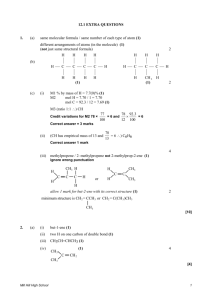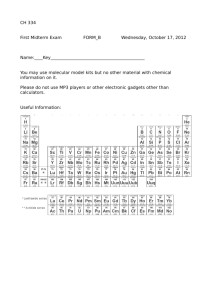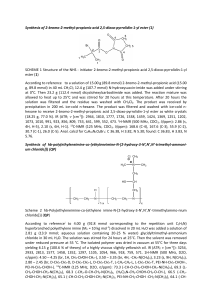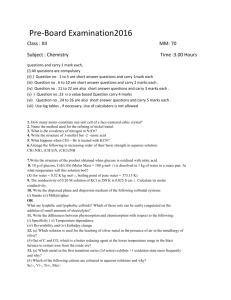Periodic Table of the Elements
advertisement
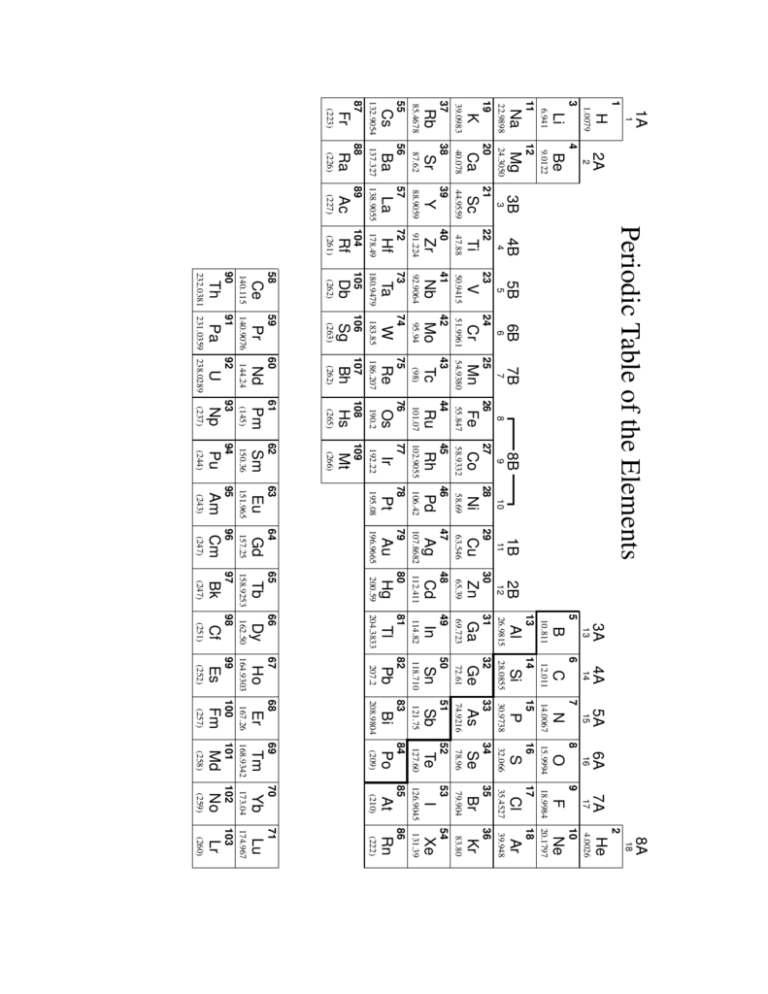
1 3 1 1A H 1.0079 Li 4 2 2A Be 9.0122 12 6.941 11 Mg 24.3050 Na 20 40.078 Ca 22.9898 19 K 39.0983 3 3B 21 Sc 44.9559 6 6B 7 7B 25 5 24 5B 23 Mn 54.9380 Cr 51.9961 V 50.9415 (98) 75 Re 186.207 107 Bh (262) 44 76 8 108 61 93 (237) Np (145) Pm (265) Hs 190.2 Os 101.07 Ru 55.847 Fe 26 9 8B 27 Co 58.9332 45 Rh 102.9055 77 Ir 192.22 Mt 109 (266) 62 Sm 150.36 94 Pu (244) 46 78 63 95 10 (243) Am 151.965 Eu 195.08 Pt 106.42 Pd 58.69 Ni 28 29 11 12 2B 30 Zn 48 65.39 47 Cd 112.411 Ag 107.8682 65 97 (247) Bk 158.9253 Tb 200.59 Hg 80 64 96 (247) Cm 157.25 Gd 196.9665 Au 79 63.546 Cu 1B Periodic Table of the Elements 4 4B 22 Ti 47.88 95.94 74 W 183.85 106 Sg (263) Tc 43 41 Db (262) Mo 42 40 38 39 37 Nb 92.9064 Zr 91.224 Ba Y 88.9059 73 Sr 72 Cs 87.62 57 180.9479 Rb 56 178.49 105 85.4678 55 138.9055 104 Rf (261) Ta 137.327 89 Ac (227) Hf 132.9054 88 Ra (226) La 87 Fr (223) 59 60 58 Nd 92 U 144.24 140.9076 Pr 140.115 91 Ce 90 Pa 231.0359 238.0289 Th 232.0381 5 13 3A B 6 14 4A C 16 6A 17 7A 2 18 8A He 4.0026 10 15 9 5A 8 (260) Lr 103 174.967 Lu 71 (222) Rn 86 131.39 Xe 54 83.80 Kr 36 39.948 Ar 18 Ne 7 20.1797 F 18.9984 O 17 35 53 85 70 102 (259) No 173.04 Yb (210) At 126.9045 I 79.904 Br 35.4527 Cl 15.9994 N 16 34 52 84 69 101 (258) Md 168.9342 Tm (209) Po 127.60 Te 78.96 Se 32.066 S 14.0067 15 12.011 14 10.811 13 P 30.9738 Si 28.0855 Al 26.9815 33 51 83 68 100 (257) Fm 167.26 Er 208.9804 Bi 121.75 Sb 74.9216 As 32 50 82 67 99 (252) Es 164.9303 Ho 207.2 Pb 118.710 Sn 72.61 Ge 31 Ga 69.723 49 In 114.82 81 Tl 204.3833 66 Dy 162.50 98 Cf (251) Create assignment, 52120, Test 2, Mar 30 at 1:30 pm This print-out should have 30 questions. Multiple-choice questions may continue on the next column or page – find all choices before answering. The due time is Central time. Lyon E3 07 18:01, general, multiple choice, > 1 min, fixed. 001 Like all equilibrium constants, Kw varies somewhat with temperature. Given that Kw is 4.95 × 10−13 at some temperature, what is the pH of a neutral aqueous solution at that temperature? 25◦ C neutral pH = 7. Ka will be smaller than 1 × 10−7 at 0◦ C because water autodissociates less than 25◦ C. pH will therefore be greater than 7 at 0◦ C. ChemPrin3e T10 19 18:99, general, multiple choice, < 1 min, fixed. 003 What is the pH of a 0.005 M aqueous solution of calcium hydroxide? 1. 11.40 2. 2.00 1. 6.15 correct 3. 12.00 correct 2. 6.06 4. 12.70 3. 6.22 5. 11.70 4. 6.34 5. 6.43 Explanation: DAL 02 0303 18:01, general, multiple choice, < 1 min, fixed. 002 Which of the following statements is true with respect to the autodissociation of water when sipping a glass of ice water? I. pH = pOH = 7 II. pH < 7 III. pH = pOH IV. pH > 7 2 Explanation: Msci 18 0408 18:01, general, multiple choice, > 1 min, fixed. 004 0.50 moles of HCN are added to a liter of water. What is the pH? (Ka of HCN is 4.0×10−10 ) 1. 4.69 2. 5.35 3. 4.85 correct 4. 9.40 1. I and III only 5. 4.35 2. III and IV only correct 3. II only 4. IV only Explanation: Since water autodissociates, [H+ ] = [OH− ]. For any given temperature, the pH of pure water is defined as neutral and pH = pOH. At Explanation: HCN is not a strong acid so [H+ ] will not be 0.5 M. To figure it out, we must look at the Ka . HCN −→ H+ + CN− Create assignment, 52120, Test 2, Mar 30 at 1:30 pm Initial 0.5 0 0 Change −x +x +x Equilibrium 0.5 − x (but x is negligible) x x x is negligible compared to 0.5 in this situation because the Ka is so small (which means the reaction isn’t going to go very much. We leave in the other two x’s in because they are not negligible compared to zero: [CN− ][H+ ] [HCN] x2 4 × 10−10 = 0.5 x = 1.4 × 10−5 = [H+ ] ¢ ¡ pH = −log 1.4 × 10−5 = 4.85 Ka = Msci 19 0007 18:06, general, multiple choice, > 1 min, fixed. 005 Rank the following 1.0 M solutions NaCN, H2 S, RbOH, CaCl2 , HI in order of DECREASING pH. 1. RbOH, NaCN, CaCl2 , H2 S, HI correct 2. CaCl2 , NaCN, H2 S, HI, RbOH 3. H2 S, HI, NaCN, RbOH, CaCl2 4. NaCN, CaCl2 , RbOH, HI, H2 S 3 3. a Brønsted acid. 4. a Brønsted base. 5. neither an acid nor a base. Explanation: Msci 18 0835 18:08, general, multiple choice, > 1 min, fixed. 007 Calculate the pH of an aqueous solution containing 0.10 M NH3 and 0.10 M NH4 Cl. Kb for NH3 is 1.8 × 10−5 . 1. 9.26 correct 2. 9.40 3. 9.70 4. 11.11 5. 9.31 Explanation: [NH3 ] = 0.10 M Kb = 1.8 × 10−5 [NH+ 4 ] = 0.10 M This is an ammonia buffer solution in which [NH3 ] = [NH+ 4 ], so pOH = pKb = − log(1.8 × 10−5 ) = 4.74473 pH = 14.00 − pOH = 9.25527 5. RbOH, CaCl2 , HI, NaCN, H2 S Explanation: DAL Acid Base Type 11:04, general, multiple choice, < 1 min, . 006 For the reaction Al3+ + 3 NH3 → Al(NH3 )3 Al3+ is best described as Msci 18 0724 18:08, general, multiple choice, > 1 min, fixed. 008 Which of the following mixtures will be a buffer when dissolved in a liter of water? 1. 0.1 mol Ca(OH)2 and 0.3 mol HI 2. 0.3 mol NaCl and 0.3 mol HCl 1. a Lewis acid. correct 3. 0.4 mol NH3 and 0.4 mol HCl 2. a Lewis base. 4. 0.2 mol HBr and 0.1 mol NaOH Create assignment, 52120, Test 2, Mar 30 at 1:30 pm 5. 0.2 mol HF and 0.1 mol NaOH correct Explanation: Eliminate answers that are obviously incorrect. The choice with “0.2 mol HBr” and “0.1 mol Ca(OH)2 ” are strong acids and strong bases respectively; therefore, NOT buffers. The choice with “0.3 mol NaCl” is a combination of spectator ions and a strong acid; this does not form a buffer. Remaining for calculation are choices with “0.4 mol NH3 ” and “0.2 mol HF”. Now perform the neutralizaton calculations on the remaining possibilities: Choice with 0.4 mol NH3 NH3 + H+ * ) NH4 + Initial 0.4 0.4 0 Change −0.4 −0.4 0.4 Final 0 0 0.4 Choice with 0.2 mol HF HF + OH− * ) F− + H 2 O Initial 0.2 0.1 0 − Change −0.1 −0.1 0.1 − Final 0.1 0 0.1 − The choice with 0.2 mol HF has both weak acid and weak conjugate base left over, so it is the buffer solution. Sparks Kb 002 18:01, general, multiple choice, < 1 min, fixed. 009 Consider the following table: Base Ionization Constant Kb value Aniline Hydroxylamine Trimethylamine 4.2 × 10−10 6.6 × 10−9 7.4 × 10−5 Which would have the strongest conjugate acid? 1. aniline correct 2. hydroxylamine 4 3. trimethylamine 4. All are equally strong. Explanation: DAL Buffer Capacity 18:08, general, multiple choice, > 1 min, . 010 A buffer is formed by mixing 100 mL of 0.2 M HClO2 and 200 mL of 0.7 M KClO2 . What volume of 0.2 M KOH can be added before the buffer capacity is reached? 1. 700 mL 2. 300 mL 3. 100 mL correct 4. 150 mL 5. 10 mL Explanation: Msci 18 0883 18:08, general, multiple choice, > 1 min, fixed. 011 If 100 mL of 0.040 M NaOH solution is added to 100 mL of solution which is 0.10 M in CH3 COOH and 0.10 M in NaCH3 COO, what will the pH of the new solution be? (Ka = 1.8 × 10−5 ) 1. 4.74 2. 4.81 3. 4.89 4. 5.00 5. 5.11 correct Explanation: [CH3 COOH] = 0.10 M [NaOH] = 0.040 M − [CH3 COO ] = 0.10 M Ka = 1.8 × 10−5 Initial condition (ini): nNaOH = 100 × 0.04 = 4 mmol Create assignment, 52120, Test 2, Mar 30 at 1:30 pm nCH3 COOH = 100 × 0.10 = 10 mmol nNa+ = 100 × 0.10 = 10 mmol nCH3 COO− = 100 × 0.10 = 10 mmol NaOH +CH3 COOH → Na+ +CH3 COO− + H2 O ini 4.0 10.0 10.0 10.0 ∆ −4.0 −4.0 4.0 4.0 fin 0 6.0 14.0 14.0 + Na is a spectator ion. CH3 COOH/CH3 COO− is a buffer system. ã ¤! CH3 COO− pH = pKa + log [CH3 COOH] µ ¶ ¡ ¢ 14.0 −5 = − log 1.8 × 10 + log 6.0 = 5.1127 3. 5.73 4. 50 5. None of these Explanation: Kb = 7.4 × 10−4 Ca = 0.5 Vdimethylamine = 100 mL 14 12 10 (50,10.9) 8 6 (100,5.73) 4 2 0 0 20 40 60 80 100 120 140 Volume of acid (mL) 12 10 8 pH Kw = 10−14 Cb = 0.5 14 pH ChemPrin3e T11 49 B 18:10, basic, numeric, > 1 min, wordingvariable. 012 The curve for the titration of dimethylamine base ((CH3 )2 NH) with HF(aq) acid is given below. 5 6 4 2 0 0 20 40 60 80 100 120 140 Volume of acid (mL) Estimate the pKb of dimethylamine base. Ca = 0.5, Cb = 0.5, and the volume of (CH3 )2 NH is 100 mL. The equivalence point of this titration is when the curve is at an inflection point; i.e., at a volume of 100 mL . The pH at the equivalence point of this titration is 5.73 pH . The pKb can be found at one-half the volume of the equivalence point; i.e., at 50 mL. The pKb is 10.9 pH from looking at the graph. The formula is µ ¶ Kw pKb = − log Kb ¶ µ 10−14 = − log 7.4 × 10−4 ³ ´ = − log 0.135135 × 10−10 = 10.8692 pH . 1. 10.9 correct 2. 100 Note: The pKb is the pH when the mole fraction is 0.5. Create assignment, 52120, Test 2, Mar 30 at 1:30 pm 6 nHNO3 = 100 × 0.100 = 10 mmol Msci 19 0722 18:10, general, multiple choice, > 1 min, fixed. 013 How many endpoints would be observed in a titration of the triprotic acid (H3 A)? 1. 3 correct ini ∆ fin NaOH + HNO3 → Na+ + NO3 − + H2 O 8 10 0 0 −8 −8 8 8 0 2 8 8 HNO3 is a strong acid, and Na+ and NO− 3 are spectator ions. Total volume = 180 mL 2. 2 3. 1 [H3 O+ ] = 4. None of these 2 mmol = 0.0111111 M 180 mL pH = − log(0.0111111) = 1.95424 5. 4 Explanation: H3 A → H + + H 2 A− H2 A → H+ + HA2− HA− → H+ + A3− These three dissociation equations show that three endpoints will be seen. DAL Equiv Pt 18:10, general, multiple choice, > 1 min, . 015 What is the pH when 100 mL of 0.1 M HI is titrated with 50 mL of 0.2 M LiOH? 1. 7 correct 2. 1 3. 13.3 Msci 19 0611 18:10, basic, multiple choice, > 1 min, fixed. 014 Calculate the pH of a solution prepared by adding 80.0 mL of 0.100 M NaOH solution to 100 ml of 0.100 M HNO3 solution. 5. 12.8 Explanation: Msci 19 0734 18:10, general, multiple choice, > 1 min, fixed. 016 A 100 mL portion of 0.300 M acetic acid is being titrated with 0.200 M NaOH solution. What is the [H+ ] of the solution after 50.0 mL of the NaOH solution has been added? The ionization constant of acetic acid is 1.8 × 10−5 . 1. 1.95 correct 2. 2.02 3. 2.08 4. 2.16 5. 2.24 Explanation: VNaOH = 80.0 mL [NaOH] = 0.100 M 4. 1.2 VHNO3 = 100 mL [HNO3 ] = 0.100 M Initial condition (ini): nNaOH = 80.0 × 0.100 = 8 mmol 1. 3.63 × 10−5 correct 2. 8.95 × 10−6 3. 1.21 × 10−5 Create assignment, 52120, Test 2, Mar 30 at 1:30 pm 4. 9.94 × 10 7 19:01, general, multiple choice, < 1 min, . 018 Given the following table −6 5. 6.01 × 10−4 Explanation: VCH3 COOH = 100 mL [CH3 COOH] = 0.300 M Ka = 1.8 × 10−5 Cmpd Ag2 S ZnS CuS Cu2 S VNaOH = 50 mL [NaOH] = 0.200 M Initially, nCH3 COOH = (100 mL)(0.3 M) = 30 mmol nNaOH = (50 mL)(0.2 M) = 10 mmol CH3 COOH+NaOH→CH3 COO− +Na+ +H2 O ini 30 10 0 0 ∆ −10 −10 10 10 fin 20 0 10 10 Na+ is a spectator ion. CH3 COOH and CH3 COO− form a buffer. Total volume = 150 mL µ ¶ [CH3 COO− ] pH = pKa + log [CH3 COOH] = − log(1.8 × 10−5 ) µ ¶ 10 mmol/150 mL + log 20 mmol/150 mL = 4.4437 [H3 O+ ] = 10−4.4437 = 3.6 × 10−5 M DAL 02 0316 18:01, general, multiple choice, < 1 min, fixed. 017 A solution of 50 mL of 0.3 M acetic acid is titrated with 75 mL of 0.2 M NaOH. What is the pH of the resulting solution? Ka for acetic acid is 1.8 × 10−5 . 1. 8.91 correct 2. 7.00 Ksp 6.3 × 10−51 1.6 × 10−24 1.3 × 10−36 2.0 × 10−47 of Ksp values for sulfides, which is the least soluble? (Hint: You can find the correct answer by performing simple math in your head.) 1. Ag2 S correct 2. ZnS 3. CuS 4. Cu2 S Explanation: Msci 20 0308 19:01, general, multiple choice, > 1 min, fixed. 019 At slightly below room temperature, the solubility product constant for Zn(OH)2 is 3.2 × 10−17 . What is the molar solubility of Zn(OH)2 in water at this temperature? 1. 2.8 × 10−9 M 2. 7.9 × 10−7 M 3. 2.0 × 10−6 M correct 4. 3.2 × 10−6 M 5. 1.0 × 10−3 M 3. 5.1 Explanation: 4. 12.1 Explanation: DAL Solubility ChemPrin3e T11 74 18:01, basic, multiple choice, < 1 min, fixed. 020 Calculate the solubility product of calcium Create assignment, 52120, Test 2, Mar 30 at 1:30 pm hydroxide if the solubility of Ca(OH)2 (s) in water at 25◦ C is 0.011 M. 1. 1.5 × 10−8 2. 1.1 × 10−5 3. 2.7 × 10−6 4. 5.3 × 10−6 correct 5. 1.2 × 10−4 Msci 18 0906 18:02, general, multiple choice, > 1 min, fixed. 022 Suppose that a sample of pure water is saturated with gaseous CO2 to form a solution of carbonic acid. Which response has the following species arranged in the order of decreasing concentrations at equilibrium (from highest concentration to lowest concentration)? 2− 1. H+ , H2 CO3 , HCO− 3 , CO3 Explanation: Msci 20 0315 19:01, basic, multiple choice, > 1 min, fixed. 021 Suppose CuBr(s) is added to a 0.050 M NaBr aqueous solution until saturation. What is the concentration of Cu+ ? (Ksp = 5.3 × 10−9 for CuBr.) 2− + 2. H2 CO3 , HCO− 3 , H , CO3 − + 3. CO2− 3 , H , HCO3 , H2 CO3 2− + 4. HCO− 3 , H2 CO3 , CO3 , H 2− 5. H2 CO3 , H+ , HCO− 3 , CO3 correct Explanation: Since carbonic acid is a weak acid, it is only partially dissociated, so in a solution of carbonic acid, the dominant species would be H2 CO3 . To the extent it does dissociate, − it dissociates into H+ and HCO− 3 . HCO3 , 2− + in turn, can dissociate into H and CO3 , but again this only happens to a very small extent. Thus more H+ will be present than 2− HCO− 3 , and very little CO3 will be present. 1. 1.1 × 10−7 correct 2. 7.3 × 10−5 3. 1.6 × 10−5 4. 2.5 × 10−3 5. 2.2 × 10−1 Explanation: Ksp = 5.3 × 10−9 8 [NaBr] = 0.05 M CuBr * ) Cu+ + Br+ Ksp = [Cu+ ] [Br− ] = 5.3 × 10−9 Let [Cu+ ] = x, and [Br− ] = x + 0.05 x (x + 0.05) = 5.3 × 10−9 PH 10 108a 18:01, general, multiple choice, > 1 min, normal. 023 Calculate the pH of 0.095 M NaH2 AsO4 (aq). pKa1 = 2.25, pKa2 = 6.77, and pKa3 = 11.6. 1. 4.51 correct x2 + 0.05 x − (5.3 × 10−9 ) = 0 Solving this quadratic equation gives x = 1.06 × 10−7 , or x = −0.05 . Since the negative value is meaningless, x = [Cu+ ] = 1.1 × 10−7 . 2. 5.62 3. 3.07 4. 9.18 5. None of these Create assignment, 52120, Test 2, Mar 30 at 1:30 pm Explanation: Initially the salt dissociates into Na+ and + H2 AsO− 4 ions. Na is an extremely weak acid and does not affect the equilibrium. There are three equilibria to consider for the anion but as we start with H2 AsO− 4 , the first and second dissociations are most pertinent; we use these to calculate pH: 1 (pKa1 + pKa2 ) 2 1 = (2.25 + 6.77) 2 = 4.51 . pH = DAL Mass Charge Balance 19:99, general, multiple choice, > 1 min, . 024 Which of the following is a correct mass balance expression for the addition of H2 CO3 to water? 2− 1. CH2 CO3 = [H2 CO3 ] + [HCO− 3 ] + [CO3 ] correct 2− − 2. [H+ ] = [HCO− 3 ] + [CO3 ] + [OH ] 2− 3. CH2 CO3 = [HCO− 3 ] + [CO3 ] 4. Kw = [H+ ] + [OH− ] Explanation: ChemPrin3e T10 52 18:99, general, multiple choice, < 1 min, fixed. 025 Which equation represents Ka2 for phosphoric acid? 1. HPO2− 4 (aq) + H2 O(`) → + PO3− 4 (aq) + H3 O (aq) 2. H2 PO− 4 (aq) + H2 O(`) → + HPO2− 4 (aq) + H3 O (aq) correct 3. H3 PO4 (aq) + 2 H2 O(`) → + HPO2− 4 (aq) + 2 H3 O (aq) 4. HPO2− 4 (aq) + H2 O(`) → − H2 PO− 4 (aq) + OH (aq) 9 5. H3 PO4 (aq) + H2 O(`) → + H2 PO− 4 (aq) + H3 O (aq) Explanation: DAL H Concen 19:99, general, multiple choice, > 1 min, . 026 Which equation would be appropriate to find the H+ concentration of a dilute solution of HBr in water? 1. [H+ ] = CHBr 2. [H+ ] = (Ka CHBr )0.5 2 3. [H+ ] + CHBr [H+ ] + Kw = 0 correct 2 4. [H+ ] + Ka [H+ ] − Ka CHBr = 0 3 5. [H+ ] + Ka [H+ ]2 −(Kw + Ka CHBr ) [H+ ] − Ka Kw = 0 Explanation: DAL Equil 19:99, general, multiple choice, < 1 min, . 027 A solution is made in which 0.1 mole of H2 SO4 is added to 1 liter of water. Which statement about [H+ ] at equilibrium is true? 1. 0.2 M < [H+ ] 2. [H+ ] = 0.2 M 3. 0.1 M < [H+ ] < 0.2 M correct 4. [H+ ] = 0.1 M 5. [H+ ] < 0.1 M Explanation: Msci 18 0918 18:02, general, multiple choice, > 1 min, fixed. 028 What is the pH of a 0.020 M solution of hydrosulfuric acid, a diprotic acid? Create assignment, 52120, Test 2, Mar 30 at 1:30 pm Ka1 = 1.1 × 10−7 Ka2 = 1.0 × 10−14 1. 7.00 2. 9.67 3. 7.84 4. 4.33 correct 5. 3.65 6. 4.69 7. 5.22 Explanation: Solve using ONLY the 1st ionization. So this works like any other monoprotic acid where the p assumption + [H ] = (Conc)(Ka1 ) is valid. ChemPrin3e T10 71 18:99, general, multiple choice, < 1 min, wording-variable. 029 Fractional Composition Consider the fractional composition diagram for the amino acid alanine. 1.0 0.8 0.6 0.4 0.2 2 4 6 8 10 12 14 pH What is the structure of the dominant species at pH 2? 1. HOOC CH(CH3 )NH+ 3 correct 2. − OOC CH(CH3 )NH+ 3 3. − OOC CH(CH3 )NH2 Explanation: 10 To the left of 2.348, the red graph representing HOOC CH(CH3 )NH+ 3 is dominant. Between 2.348 and 9.867, the blue graph representing − OOC CH(CH3 )NH+ is 3 dominant. To the right of 9.867, the green graph representing − OOC CH(CH3 )NH2 is dominant. DAL 02 0307 18:01, general, multiple choice, < 1 min, fixed. 030 For which of the following solutions of a weak acid would you feel most confident of an accurate answer in using the equation p + [H ] = Ka Ca ? 1. 0.0005 M solution with a Ka of 2.7×10−8 2. 0.2 M solution with a Ka of 2.3 × 10−3 3. 0.2 M solution with a Ka of 2.7 × 10−8 correct 4. 0.0005 M solution with a Ka of 2.3×10−3 Explanation: x2 , x = [H+ ], when Ka is a Ca − x small, the acid dissociates very little, resulting in a small x. If Ca is large and x is small then Ca − x ≈ C a . For Ka =



